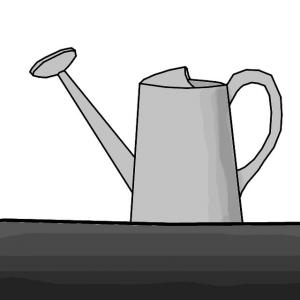Executive Summary
Manual irrigation systems are very simple, but effective methods for making water available to crops. Manual irrigation systems are easy to handle and there is no need for technical equipment. But it is important that they are constructed correctly to avoid water loss and crop shortfall. The systems allow for high self-help compatibility and have low initial capital costs. They can be used in almost every area, but they are especially adapted for arid areas where evaporation rates are high.
Introduction
Manual irrigation systems are easy to handle, require no technical equipment and are therefore generally cheap (in contrast to high-tech systems such as sprinkler irrigation or subsurface drip irrigation). But they need high labour inputs. A common and very simple technique for manual irrigation is for instance the use of watering cans as it can be found in peri-urban agriculture around large cities in some African countries. A more sophisticated and very water-efficient type of manual irrigation system is small-scale drip irrigation with buckets (see also drip irrigation). Beside these systems, there are many other methods for manual irrigation, which are easy to install and simple to use. In general, all of these methods have high self-help compatibility and a relatively high performance. Therefore such systems are also called HELPFUL irrigation methods: High-frequency, Efficient, Low-volume, Partial-area, Farm-Unit, and Low-cost (FAO 1997).
Basic Manual Irrigation Principles
Low-Cost Drip Irrigation System
Simple drip irrigation (in contrary to high tech drip irrigation systems) uses low-cost plastic pipes cut to the appropriate lengths laid on the ground to irrigate vegetables, field crops and orchards. Small holes in the hose allow water to drip out and keep the base of the plant wet without wasting any water. Read more about it here.
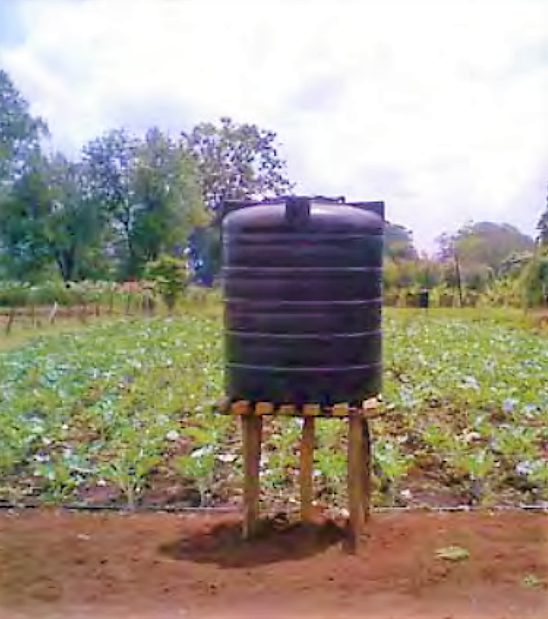
Watering Cans
Irrigation by watering cans is a very basic way but is still widely used.This creates a lot of work for the labours especially if this technique is used for large fields. A common way to make this work easier is a carry-pole across the shoulders. The field worker is able to carry two big watering cans in each side and the irrigation water can de distributed equally on the field. A rose can be added to the watering-can to create a “sprinkler effect” (see picture).
With watering cans, the field worker is able to irrigate very specific and only where it is necessary.
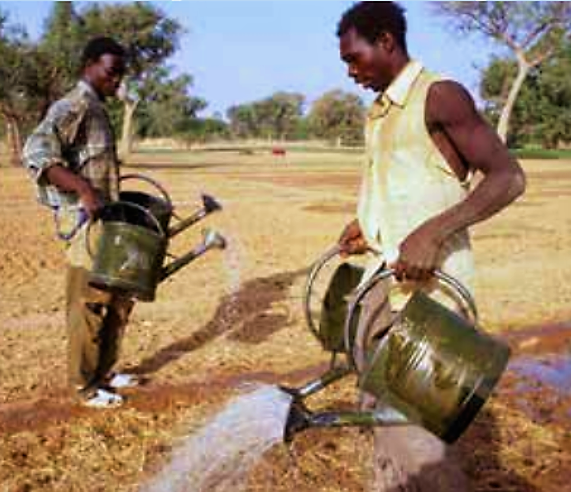
Pitcher Irrigation
(Adapted from: FAO 1997 and INFONET-BIOVISION 2010)
A very basic subsurface (see also subsurface drip irrigation) method consists in placing porous clay jars (or pots) in shallow pits dug for this purpose. Soil is then packed around the necks of the jars so that their rims protrude a few centimetres above the ground surface. Water is poured into the jars either by hand or by means of a flexible hose connected to a water source. Since the walls of the pots are porous (make sure to use unglazed pots), the water can seep slowly out and reach the roots of the plants. The jars can be made of locally available clay: they are of no standard shape, size, wall thickness or porosity. Instead of a clay or earthenware pod, also the sweet monkey orange fruit (Strychnos spinosa) can be used when it has been dried and the top cut off. The jar should be filled up regularly (especially in arid areas) and has to be changed if there are big cracks that the water percolates without reaching the roots.
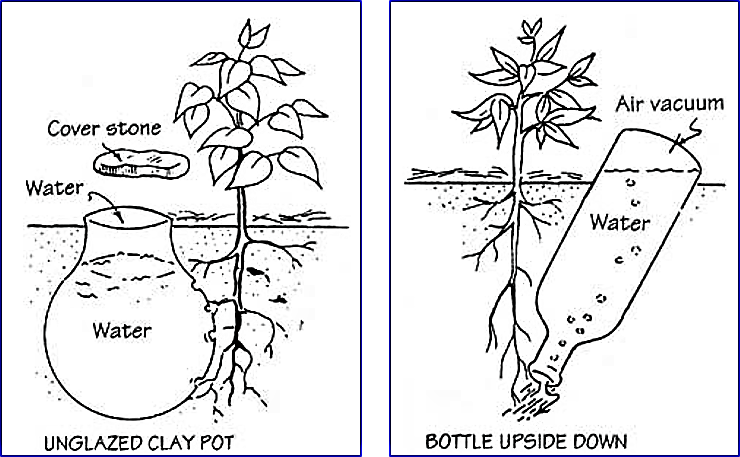
Bottle Irrigation
(Adapted from INFONET-BIOVISION 2010)
Similar to the pot method described above, pitcher irrigation can also be done using a bottle. The bottle is first filled and than placed with its neck into the soil next to a plant, so it stands upside down (see picture above). The dense soil hinders the water from leaving the bottle immediately. Instead, it gets released slowly and directly besides the roots, so it is available to the plant for a longer time and the water cannot evaporate directly.
Porous and Sectioned Pipes
(Adapted from FAO 1997)
Another variation of pitcher irrigation uses porous pipes instead of pots to spread water along a continuous horizontal band in the soil, rather than at discrete locations. As such, the porous pipe method is more suitable for closely spaced row crops grown in beds, such as vegetable crops. One end of the porous pipe is made protrude above ground that the operator is able to refill it with water as soon as it is necessary. In contrast to subsurface drip irrigation, the porous pipe distributes the water over the whole length and not only where it is perforated. That means it is less effective and water loss is slightly higher.
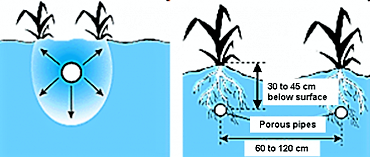
Perforated Plastic Sleeves
(Adapted from FAO 1997)
An interesting variation of the pitcher method is the use of thin plastic sheeting to form a sleeve-like casing. To define its comparative usefulness better, the method should be tested side by side with alternative methods of irrigation. To date, this has not been done systematically.
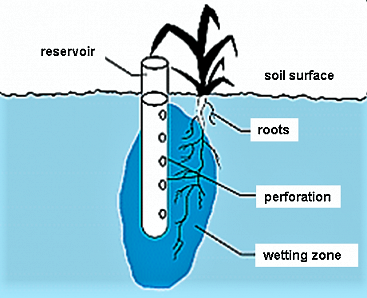
Costs Considerations
All of the described systems are very cheap. Many of them can be made out easily available material (e.g. old buckets or bottles) or renewable resources (bamboo). This reduces the costs significantly. However, high labour inputs are required for operation and maintenance.
Operation and Maintenance
As water is brought into the system manually, this requires high labour input. Moreover, it is important to check the systems regularly to prevent blockages and leakages. If there are any problems it should be cleaned and/or fixed as fast as possible to prevent damages on crops. Furthermore, there are several techniques to improve the production and avoid water loss on the fields. See crop selection.
Health Aspects
(Adapted from TILLEY et al. 2014)
If wastewater is used for the manual irrigation process, there are potential health risks if water is not properly pre-treated (i.e. inadequate pathogen reduction). If poorly treated wastewater is applied. Appropriate pre-treatment should precede any irrigation scheme to limit health risks to those who come in contact with the water. As well, depending on the degree of treatment that the effluent has undergone, it may be contaminated with the different chemicals that are discharged into the system. When effluent is used for irrigation, households and industries connected to the system should be made aware of the products that are and are not appropriate for discharging into the system. Drip irrigation and subsurface drip irrigation are the only types of irrigation that should be used with edible crops, and even then, care should be taken to prevent workers and harvested crops from coming in contact with the treated effluent. Despite safety concerns, irrigation with effluent is an effective way to recycle nutrients and water (see also fertigation or waterborne diseases pathogens and contaminants).
Manual irrigation methods are appropriate for small-scale farming or backyard gardening irrigation in dry and arid climates where water is scarce. All the different designs reduce water evaporation. It allows people to grow its own food with simple but effective techniques.
Small-scale Irrigation for Arid Zones. Principles and Options
This publication is an attempt to distil current information on irrigation methods that might be appropriate, and to offer some ideas on the possible adoption and adaptation of such methods by small-scale farmers in the semi-arid areas of sub-Saharan Africa.
FAO (1997): Small-scale Irrigation for Arid Zones. Principles and Options. Rom: Food and Agriculture Organisation of the United Nations (FAO) URL [Accessed: 23.06.2011]FAO and Emergencies
Water for Irrigation
Infonet-biovision.org is a web-based information platform offering trainers, extension workers and farmers in East Africa a quick access to up-to-date and locally relevant information in order to optimise their livelihoods in a safe, effective, sustainable and ecologically sound way.
INFONET-BIOVISION (2010): Water for Irrigation. Zürich: Biovision URL [Accessed: 09.04.2019]Grid – IPTRID Network Magazine. February 2008
GRID is published to assist communication between researchers and professionals in the spheres of irrigation and drainage.
IPTRID (2008): Grid – IPTRID Network Magazine. February 2008. Rome: International Programme for Technology and Research in Irrigation and Drainage (IPTRID) URL [Accessed: 07.05.2019]Compendium of Sanitation Systems and Technologies. 2nd Revised Edition
This compendium gives a systematic overview on different sanitation systems and technologies and describes a wide range of available low-cost sanitation technologies.
TILLEY, E., ULRICH L., LÜTHI, C., REYMOND P. and ZURBRÜGG C. (2014): Compendium of Sanitation Systems and Technologies. 2nd Revised Edition. Duebendorf, Switzerland: Swiss Federal Institute of Aquatic Science and Technology (Eawag) URL [Accessed: 03.05.2023] PDFSmall-scale Irrigation for Arid Zones. Principles and Options
This publication is an attempt to distil current information on irrigation methods that might be appropriate, and to offer some ideas on the possible adoption and adaptation of such methods by small-scale farmers in the semi-arid areas of sub-Saharan Africa.
FAO (1997): Small-scale Irrigation for Arid Zones. Principles and Options. Rom: Food and Agriculture Organisation of the United Nations (FAO) URL [Accessed: 23.06.2011]Water for Irrigation
Infonet-biovision.org is a web-based information platform offering trainers, extension workers and farmers in East Africa a quick access to up-to-date and locally relevant information in order to optimise their livelihoods in a safe, effective, sustainable and ecologically sound way.
INFONET-BIOVISION (2010): Water for Irrigation. Zürich: Biovision URL [Accessed: 09.04.2019]Grid – IPTRID Network Magazine. February 2008
GRID is published to assist communication between researchers and professionals in the spheres of irrigation and drainage.
IPTRID (2008): Grid – IPTRID Network Magazine. February 2008. Rome: International Programme for Technology and Research in Irrigation and Drainage (IPTRID) URL [Accessed: 07.05.2019]Gardening with Low-Cost Drip Irrigation in Kenya:
The purpose of the study was to evaluate the potential and technical aspects of improving irrigation performance and reducing poverty simultaneously through applying a market creation approach to development.
KELLER, J. (2001): Gardening with Low-Cost Drip Irrigation in Kenya:. URL [Accessed: 27.06.2011]Low Cost Drip Irrigation Manual
This two-page paper manual describes the low-cost drip irrigation.
RCSD (Editor) (2008): Low Cost Drip Irrigation Manual. Assam: Resources Centre for Sustainable Development (RCSD) URLCompendium of Sanitation Systems and Technologies
This compendium gives a systematic overview on different sanitation systems and technologies and describes a wide range of available low-cost sanitation technologies.
TILLEY, E., LUETHI, C., MOREL, A., ZURBRUEGG, C. and SCHERTENLEIB, R. (2008): Compendium of Sanitation Systems and Technologies. Duebendorf, Switzerland: Swiss Federal Institute of Aquatic Science and Technology (EAWAG) and Water Supply and Sanitation Collaborative Council (WSSCC) URL [Accessed: 15.02.2010] PDFUrine as Liquid Fertilizer in Agricultural Production in the Philippines
This field guide has been developed to accommodate the ever-increasing demand for more detailed and scientifically backed information on how to use urine in agricultural production. It is intended primarily for practitioners and experts in the water, sanitation, planning, and agriculture sectors, as well as local and national government officials from the various sectors, NGO and individuals interested and working in the field of agriculture and sustainable sanitation in the Philippines and the wider Southeast Asian region.
GENSCH, R. MISO, A. ITSCHON, G. (2011): Urine as Liquid Fertilizer in Agricultural Production in the Philippines. Cagayan de Oro: Sustainable Sanitation Center Xavier University (XU), the Philippine Sustainable Sanitation Knowledge Node, the Philippine Ecosan Network, and the Sustainable Sanitation Alliance (SuSanA) URL [Accessed: 07.05.2019]Technical Manual for Ideal Micro Irrigation Systems
This manual features comprehensive parts lists and instructions for assembling low-cost drip irrigation systems.
IDE (n.y): Technical Manual for Ideal Micro Irrigation Systems. Golden: International Development Enterprises URL [Accessed: 07.05.2019]Pedaling out of Poverty: Social Impact of a Manual Irrigation Technology in South Asia
This paper offers an assessment of the social impact of treadle pump technology for manual irrigation in eastern India, the Nepal Terai, and Bangladesh, South Asia’s so-called “poverty square.” This region where 500 million of the world's poorest people live is underlain by one of the world’s best groundwater resources. Treadle pump technology can be a powerful tool for poverty reduction in this region. It “self-selects” the poor and it puts to productive use the region’s vast surplus family labor. It is claimed that the treadle pump could raise the annual net household income by US$100, on the average.
SHAH, T. ALAM, M. DINESH KUMAR, M. NAGAR, R.K. SINGH, M. (2000): Pedaling out of Poverty: Social Impact of a Manual Irrigation Technology in South Asia. (= Research Report , 45 ). Battaramulla: International Water Management Institute (IWMI) URL [Accessed: 07.05.2019]Irrigation Practice and Policy in the Lowlands of the Horn of Africa
The drought of 2011 and the famine that followed in politically instable Somalia highlighted the vulnerability of the lowlands of the Horn of Africa. It is a story revisited with high frequency – 2000, 2005, and 2008. Climate variability is easily mentioned as the main attributing factor. Clearly it is – but there is also extensive land use change, because of the widespread invasion of invasive species (prosopis in particular) and the decimation of natural wood stands for charcoal production (particularly in Somalia). 2011 was a crisis year – but even in a normal years food insecurity is common. In the Afar lowlands in Ethiopia food aid has become part of the livelihoods, with most of the people dependent on it – including reportedly middle class families. There is a growing realization that water resource development – appropriate to the context – has to have a place in addressing food insecurity in the Horn of Africa. This paper focuses on irrigation policy and practice in the arid lowlands of the Horn that have been hit hardest and most frequent in the drought episodes
ALEMEHAYU, T. DEMISSIE, A. LANGAN, S. EVERS, J. (2011): Irrigation Practice and Policy in the Lowlands of the Horn of Africa. Rome: Food and Agriculture Organization of the United Nations (FAO) URL [Accessed: 26.03.2012]Development of Guidance for Sustainable Irrigation Use of Greywater In Gardens and Small-Scale Agriculture in South Africa
There are presently no formal guidelines for the use of greywater in South Africa. This paper presents the rationale and framework of a guidance document for the sustainable use of greywater to irrigate gardens and small-scale agriculture in South Africa, developed under the auspices of the Water Research Commission.
RODDA, N. CARDEN, K. ARMITAGE, N. PLESSIS, H.M. du (2011): Development of Guidance for Sustainable Irrigation Use of Greywater In Gardens and Small-Scale Agriculture in South Africa. Pretoria: Water Research Commission (WRC) URL [Accessed: 07.05.2019]Wastewater Irrigation and Health
This book is written for practitioners, researchers and graduate students in environmental and public health, sanitary and agricultural engineering, and wastewater irrigation management in developing countries. In particular, it should be useful for all those working to assess and mitigate health risks from the use of wastewater and faecal sludge in agriculture, under conditions where wastewater treatment is absent or inadequate to safeguard public health. In this respect, the book builds on and complements the international Guidelines for the Safe Use of Wastewater, Excreta and Greywater published in 2006 by the World Health Organization in collaboration with the Food and Agriculture Organization of the United Nations and the United Nations Environment Programme.
DRECHSEL, P. ; SCOTT, C.A. ; RASCHID-SALLY, L. ; REDWOOD, M. ; BAHRI, A. (2010): Wastewater Irrigation and Health. Assessing and Mitigating Risk in Low-Income Countries. London: Earthscan URL [Accessed: 07.05.2019]Simple Drip Irrigation
This PDF-presentation shows photos of drip system components and installations in Nepal.
IDE (n.y): Simple Drip Irrigation. Golden: International Development Enterprises (iDE). [Accessed: 30.11.2011] PDFChinese watering cans
This websites describes traditional farming in China and what watering cans have been used.
International Development Enterprises (IDE)
The website of International Development Enterprises (IDE) contains many (technology-)documents, photos and information about the water and agricultural section in developing countries.

